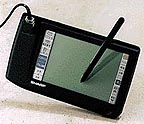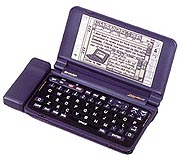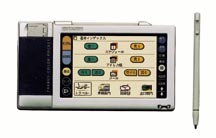(April 4, 2001/June 28, 2003) -
A while ago, Zaurus fan Doug Roach wrote us and asked whether we couldn't put up at least an archive section for Sharp's
line of Zaurus PDAs. I thought it was a good idea since we did cover the Zaurus throughout its life, but then I got busy with current affairs and forgot about the Zaurus project until
Doug wrote again.
 In this day and age of Palm and Handspring-mania, it's easy to forget that it once was the Newton and the Sharp Zaurus that ruled the world of PDAs. Even though Sharp's own
(and hugely successful) Japanese Zaurus (see image to the right and view Zaurus evolution chart) didn't have a keyboard and used handwriting recognition, the rocky start of the Apple Newton led Sharp to introduce a keyboard-based
PDA in the US in 1995, the Sharp Zaurus K-PDA (for Keyboard-PDA). The K-PDAs looked very much like larger versions of earlier Sharp organizers, and also like the first and second
generation of Windows CE-based Handheld PCs that came later.
In this day and age of Palm and Handspring-mania, it's easy to forget that it once was the Newton and the Sharp Zaurus that ruled the world of PDAs. Even though Sharp's own
(and hugely successful) Japanese Zaurus (see image to the right and view Zaurus evolution chart) didn't have a keyboard and used handwriting recognition, the rocky start of the Apple Newton led Sharp to introduce a keyboard-based
PDA in the US in 1995, the Sharp Zaurus K-PDA (for Keyboard-PDA). The K-PDAs looked very much like larger versions of earlier Sharp organizers, and also like the first and second
generation of Windows CE-based Handheld PCs that came later.
 In almost every respect, the Zaurus line was a success. The initial Zaurus 5000 was a great (albeit, at US$749 sans modem, pricey) product right from the start (reviewed in Pen #4, April 1995), one that capitalized from, and built on, Sharp's
vast experience with organizers and Japanese market PDAs. The 5700 and 5800 models followed and honed the concept to near perfection. Sharp then introduced the Zaurus 3000 and 3500, less expensive models that contained almost all the functionality
of the 5000 series. The company also tantalized us with color versions of the Japanese Zaurus (see below right) which, sadly, never made it to the US.
In almost every respect, the Zaurus line was a success. The initial Zaurus 5000 was a great (albeit, at US$749 sans modem, pricey) product right from the start (reviewed in Pen #4, April 1995), one that capitalized from, and built on, Sharp's
vast experience with organizers and Japanese market PDAs. The 5700 and 5800 models followed and honed the concept to near perfection. Sharp then introduced the Zaurus 3000 and 3500, less expensive models that contained almost all the functionality
of the 5000 series. The company also tantalized us with color versions of the Japanese Zaurus (see below right) which, sadly, never made it to the US.
 When Microsoft introduced Windows CE in the fall of 1996, Sharp first passed, then (reluctantly) introduced the CE-based Mobilon series. Even though, in retrospect, the Zaurus K-PDAs were arguably better machines than most of the Mobilons, the K-PDA was
doomed. Sharp offered them for a while longer, then quietly let them die. Today, when you search the Sharp USA website for "Zaurus," nothing comes up. And Sharp has pretty much abandoned the mobile market, neither offering a Windows CE nor a Palm-based PDA or
handheld. That is too bad.
When Microsoft introduced Windows CE in the fall of 1996, Sharp first passed, then (reluctantly) introduced the CE-based Mobilon series. Even though, in retrospect, the Zaurus K-PDAs were arguably better machines than most of the Mobilons, the K-PDA was
doomed. Sharp offered them for a while longer, then quietly let them die. Today, when you search the Sharp USA website for "Zaurus," nothing comes up. And Sharp has pretty much abandoned the mobile market, neither offering a Windows CE nor a Palm-based PDA or
handheld. That is too bad.
 When I spent a week in Japan in late 1998, courtesy of Sharp, I fell in love with the Japanese Zaurus line all over again. The then brand-new Color Pocket Zaurus fascinated me so much that I bought one at Tokyo's famous Akihabara. The Pocket Color Zaurus ws the first device ever to
have a reflective color TFT display. I brought it back to the States and showed it to everyone, including Microsoft at a Windows CE Reviewer's Confrence. The HR-TFT creen eventually made it into the Compaq Aero 2100 Series of palm-size PCs and the rest is history.
When I spent a week in Japan in late 1998, courtesy of Sharp, I fell in love with the Japanese Zaurus line all over again. The then brand-new Color Pocket Zaurus fascinated me so much that I bought one at Tokyo's famous Akihabara. The Pocket Color Zaurus ws the first device ever to
have a reflective color TFT display. I brought it back to the States and showed it to everyone, including Microsoft at a Windows CE Reviewer's Confrence. The HR-TFT creen eventually made it into the Compaq Aero 2100 Series of palm-size PCs and the rest is history.
 In 2001, Sharp introduced a new Zaurus, the MI-E1, in
Japan. It looked like a Pocket PC PDA, but had a tiny pull-down keybord, a CF Card adapter and even a Smart Disk slot. In Japan, the Zauri still
reigned supreme, and the new MI line certainly
looked very attractive. You could say it, in some small way, it was the spiritual descendant of the old K-PDA.
In 2001, Sharp introduced a new Zaurus, the MI-E1, in
Japan. It looked like a Pocket PC PDA, but had a tiny pull-down keybord, a CF Card adapter and even a Smart Disk slot. In Japan, the Zauri still
reigned supreme, and the new MI line certainly
looked very attractive. You could say it, in some small way, it was the spiritual descendant of the old K-PDA.
Thrillingly, Sharp brought the new model to the US, first as just a
"developer's edition (the SL-5000) and then as a consumer model (the
SL-5500). Though based on contemporary electronics (a 206 MHz StrongARM
processor and a sidelit reflective color display), the SL-5500 departed from
Palms and Pocket PCs by using an embedded version of Linux. This made it
both incredibly powerful, in the right hands, and a questionable choice for
those who want a simple organizer that can also play music and has lots of
commercial software. In fact, Sharp did an incredible job in putting a
friendly, attractive interface on top of Linux. Most software executes
considerably faster than on competiting Pocket PCs, the browser is
lightyears ahead in speed and features, and even though the SL-5500 uses the
same 240 x 320 resolution of Pocket PCs, you'd swear it was twice as much.
In 2003, Sharp introduced the SL-5600. The primary difference is the use of
an even speedier and more power-efficient 400MHz intel XScale processor.
Subsequently, we spent some time with later SL-Series models, but Sharp did not seem too interested in making them available to anyone but vertical market clients. The Linux-based devices continued to impress and developed a cult following. I spent a few months with one, downloaded most of the then-available software and marveled that almost whatever I did on our Linux servers, I could do on the Zaurus. Yet, something was always missed. If the technology wasn't a bit behind, the software wasn't quite fully dveloped, or some crucial part didn't work quite right. It was clearly a platform for those who had the time and dedication to truly work with it. It was anti-Microsoft more than pro-Linux. As a great fan and supporter of Sharp, it pained me to see this great company, and one of the true pioneers in PDAs, languish on this uncertain course that ultimately didn't lead anywhere.
"Historic" Pen Computing Zaurus K-PDA coverage:
Zaurus Column PCM#10 (May 96)
Zaurus Column PCM#11 (Jul 96)
Sharp Zaurus ZR-5800
Clipboard Link for Windows
Evan Sohn Interview (Zaurus Developer)
PDA Panache Pens for Newton & Zaurus
Zaurus Mail








 In this day and age of Palm and Handspring-mania, it's easy to forget that it once was the Newton and the Sharp Zaurus that ruled the world of PDAs. Even though Sharp's own
(and hugely successful) Japanese Zaurus (see image to the right and view
In this day and age of Palm and Handspring-mania, it's easy to forget that it once was the Newton and the Sharp Zaurus that ruled the world of PDAs. Even though Sharp's own
(and hugely successful) Japanese Zaurus (see image to the right and view  In almost every respect, the Zaurus line was a success. The initial Zaurus 5000 was a great (albeit, at US$749 sans modem, pricey) product right from the start (reviewed in Pen #4, April 1995), one that capitalized from, and built on, Sharp's
vast experience with organizers and Japanese market PDAs. The 5700 and 5800 models followed and honed the concept to near perfection. Sharp then introduced the Zaurus 3000 and 3500, less expensive models that contained almost all the functionality
of the 5000 series. The company also tantalized us with color versions of the Japanese Zaurus (see below right) which, sadly, never made it to the US.
In almost every respect, the Zaurus line was a success. The initial Zaurus 5000 was a great (albeit, at US$749 sans modem, pricey) product right from the start (reviewed in Pen #4, April 1995), one that capitalized from, and built on, Sharp's
vast experience with organizers and Japanese market PDAs. The 5700 and 5800 models followed and honed the concept to near perfection. Sharp then introduced the Zaurus 3000 and 3500, less expensive models that contained almost all the functionality
of the 5000 series. The company also tantalized us with color versions of the Japanese Zaurus (see below right) which, sadly, never made it to the US. When Microsoft introduced Windows CE in the fall of 1996, Sharp first passed, then (reluctantly) introduced the CE-based Mobilon series. Even though, in retrospect, the Zaurus K-PDAs were arguably better machines than most of the Mobilons, the K-PDA was
doomed. Sharp offered them for a while longer, then quietly let them die. Today, when you search the Sharp USA website for "Zaurus," nothing comes up. And Sharp has pretty much abandoned the mobile market, neither offering a Windows CE nor a Palm-based PDA or
handheld. That is too bad.
When Microsoft introduced Windows CE in the fall of 1996, Sharp first passed, then (reluctantly) introduced the CE-based Mobilon series. Even though, in retrospect, the Zaurus K-PDAs were arguably better machines than most of the Mobilons, the K-PDA was
doomed. Sharp offered them for a while longer, then quietly let them die. Today, when you search the Sharp USA website for "Zaurus," nothing comes up. And Sharp has pretty much abandoned the mobile market, neither offering a Windows CE nor a Palm-based PDA or
handheld. That is too bad.
 When I spent a week in Japan in late 1998, courtesy of Sharp, I fell in love with the Japanese Zaurus line all over again. The then brand-new Color Pocket Zaurus fascinated me so much that I bought one at Tokyo's famous Akihabara. The Pocket Color Zaurus ws the first device ever to
have a reflective color TFT display. I brought it back to the States and showed it to everyone, including Microsoft at a Windows CE Reviewer's Confrence. The HR-TFT creen eventually made it into the Compaq Aero 2100 Series of palm-size PCs and the rest is history.
When I spent a week in Japan in late 1998, courtesy of Sharp, I fell in love with the Japanese Zaurus line all over again. The then brand-new Color Pocket Zaurus fascinated me so much that I bought one at Tokyo's famous Akihabara. The Pocket Color Zaurus ws the first device ever to
have a reflective color TFT display. I brought it back to the States and showed it to everyone, including Microsoft at a Windows CE Reviewer's Confrence. The HR-TFT creen eventually made it into the Compaq Aero 2100 Series of palm-size PCs and the rest is history. In 2001, Sharp introduced a new Zaurus, the MI-E1, in
Japan. It looked like a Pocket PC PDA, but had a tiny pull-down keybord, a CF Card adapter and even a Smart Disk slot. In Japan, the Zauri still
reigned supreme, and the new MI line certainly
looked very attractive. You could say it, in some small way, it was the spiritual descendant of the old K-PDA.
In 2001, Sharp introduced a new Zaurus, the MI-E1, in
Japan. It looked like a Pocket PC PDA, but had a tiny pull-down keybord, a CF Card adapter and even a Smart Disk slot. In Japan, the Zauri still
reigned supreme, and the new MI line certainly
looked very attractive. You could say it, in some small way, it was the spiritual descendant of the old K-PDA.